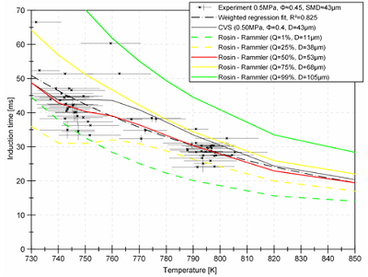simulation of spray ignition

Ignition of a fuel spray is an extremely complex process.
It includes:
- The physical processes of heating and vaporization
- Chemical reactions in the low- and high temperature regime
- Droplet-droplet interactions
- Droplet-Air stream interactions
However, the starting point to tackle the problem is the single droplet.
Drop tower experiments on large single droplets (0.75 mm) serve for validation of the related numerical simulations.
When agreement is achieved, the problem is physically and chemically understood.
The next step is to expand numerical simulations towards small single droplets of technical size. This requests for the implementation of small virtual closed vessels (CVS) containing the droplet and an amount of air that represents an overall equivalence ratio that allows for ignition. This is due to the fact that s single small droplet would not ignite in a large volume of hot air even at the highest temperatures as the fuel dissipates faster than the induction time would last.
Assuming that a spray diverges in general from the nozzle (fuel rich) towards the overall lean conditions, this virtual vessel must become larger during the ignition simulation within the next step of complication. To what extend depends on the injection configuration and the turbulent mixing processes.
This is incorporated by coupling single droplet simulations to physical CFD-simulations.
The final result is a numerical prediction of the plane where ignition happens most probably. This is the numerical prediction of the spray autoignition – this for all flow configurations.
The related projects are supported by the German Aerospace Center, DLR and the European Space Agency, ESA


 "
"